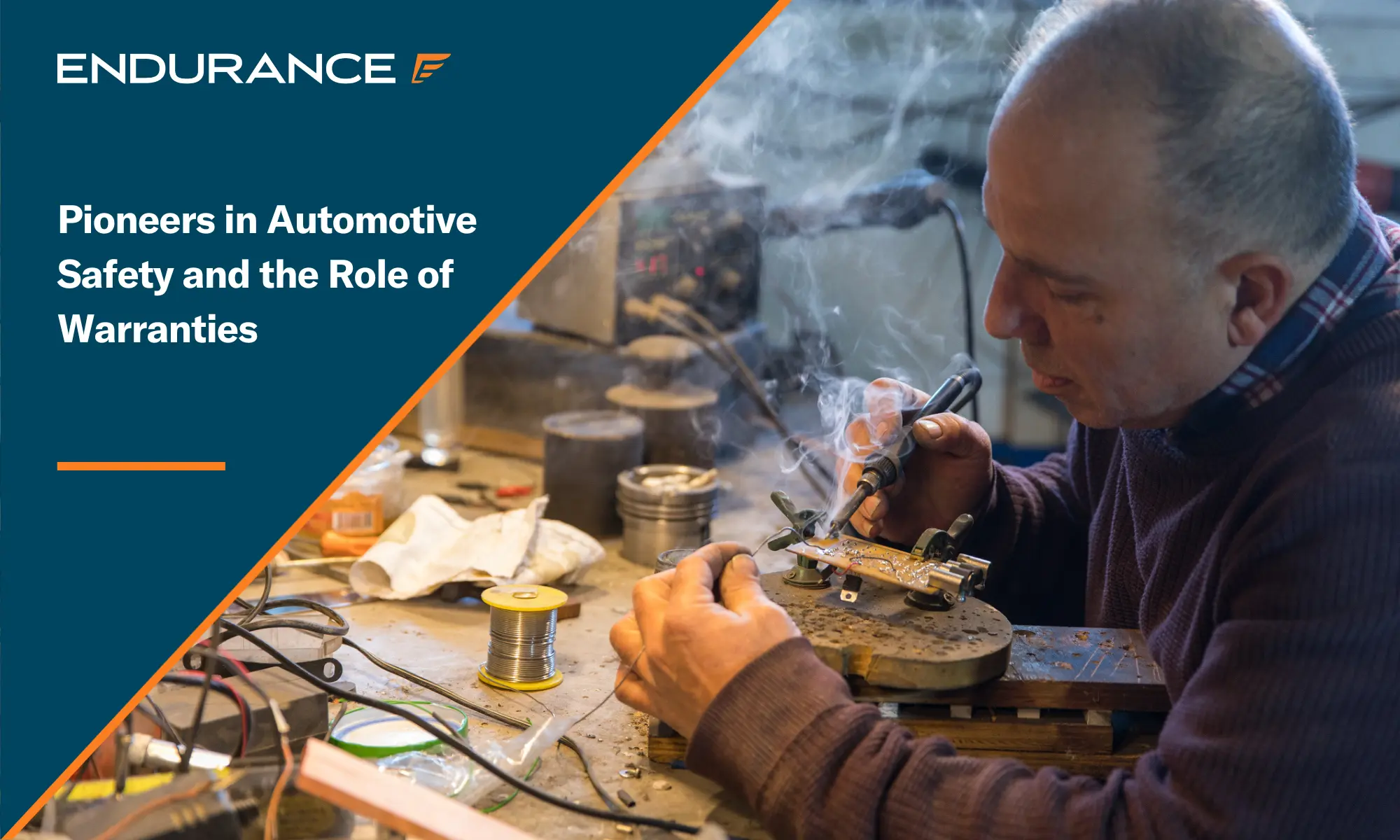Get this deal! Call now.
Speak with a vehicle protection plan specialist and get $300 off any new contract instantly.
Call 866-678-4172
or scan the code below


When looking at the history of the automobile, there is no question that the automotive industry has come a long way. Everything from how engines produce horsepower to the comfort and convenience features we now take for granted has been the product of innovation and an eye for consumers’ needs.
Each of these steps forward was the brainchild of an inventor or designer who understood that vehicles needed to be safer and more efficient. With Inventors Day on February 11th in America, looking at how far the automobile has come in the last century is a good idea.
While there have been innovations in every aspect of traditional automobile design, nowhere have they been more important than when it comes to safety. Vehicles are safer now than ever before, thanks to some forward-thinking individuals who thought outside the box and figured out how to protect you and your family when you are on the road.
Knowing what some of these innovations are and what is in store for the future will help you understand how important safety is and how you can keep yourself and others out of harm’s way whenever you are behind the wheel.
From the very first time that people got behind the wheel of a motorized vehicle, there have been safety concerns. Fortunately, there have also been automakers and designers who have made it their mission to make cars as safe as possible. While it is clear that a modern vehicle is safer than one built 100 years ago, some specific innovations and inventions stand out as particularly helpful.
In the early days of the automobile, there was a tendency for vehicles to skid when the brakes were applied for too long. This was because when a wheel simply stops spinning, the surface in contact with the road will slide along the road instead of stopping the car. For many years, traditional wisdom dictated that the driver had to pump the brakes to prevent skidding. With anti-lock braking systems, though, this was done automatically.
ABS was standardized in vehicles in the 1970s but has been around as a concept since the early 20th century. The first patent for an anti-lock braking system was registered by German engineer Karl Wessel in 1928 and began to be implemented on jet landing gear in the 1950s. Now, every new vehicle sold has ABS, so you can be sure your car will stop efficiently should you slam on the brakes unexpectedly.
 When you are in an automobile accident, the last thing you want is for your body to move around the vehicle’s cabin. This was an issue for many years, even with the standardization of seat belts, but airbags have quickly become the go-to piece of safety equipment that prevents injury during an accident. John W. Hetrick registered a patent for a spring-loaded, inflated airbag in 1951. This design used compressed air triggered by bumper contact or even manually by the driver and inflated in the vehicle’s cabin. Since the 1990s, they have become standard safety equipment in all vehicles and have saved countless lives.
When you are in an automobile accident, the last thing you want is for your body to move around the vehicle’s cabin. This was an issue for many years, even with the standardization of seat belts, but airbags have quickly become the go-to piece of safety equipment that prevents injury during an accident. John W. Hetrick registered a patent for a spring-loaded, inflated airbag in 1951. This design used compressed air triggered by bumper contact or even manually by the driver and inflated in the vehicle’s cabin. Since the 1990s, they have become standard safety equipment in all vehicles and have saved countless lives.
In an accident, you want to be sure that the rapid deceleration is spread evenly around your body so no one point takes too much pressure. While lap belts were common in vehicles, Volvo engineer Nils Bohlin designed the three-point seat belt in 1959, first introduced as standard equipment in the 1959 Volvo 122. The National Highway Traffic Safety Administration (NHTSA) estimates that this deceptively simple invention saves 15,000 lives every year by ensuring that the pressure of a crash is distributed around the whole body instead of in one area.
In recent years, massive steps have been taken toward making cars safer than ever. With advancements in sensor and vehicle control module technology, there are more and more opportunities to make vehicles recognize certain situations and adjust automatically. This takes the onus off the driver and ensures the vehicle can avoid accidents whenever possible and reduce the impact when necessary.
In the last several years, driver assistance systems have become standard for makes and models of all kinds. These systems include things like lane-keeping assist, blind-spot monitoring, lane-departure warning, and automated emergency braking. For all of these driver assistance systems, the vehicle’s control module constantly monitors the road and the driving conditions around the car. When something happens, like a pedestrian stepping out in front of the vehicle or a slight drift outside a lane, the vehicle makes automatic corrections. While it is still important for the driver to pay attention, the assistance systems can act as a second pair of eyes and keep everyone on the road safe.
 Traffic sign recognition is an emerging technology that scans the road ahead for different street signs and signals that are relevant to the driver. Using sensors, the system looks for things like Do Not Enter signs, stop signs, and speed limit signs and either displays them in-dash or relays that information to the driver. This is an extra chance for the driver to see the street signs that might be obscured or difficult to see from the driver’s seat so they can be sure to abide by the laws and keep themselves and others safe on the road.
Traffic sign recognition is an emerging technology that scans the road ahead for different street signs and signals that are relevant to the driver. Using sensors, the system looks for things like Do Not Enter signs, stop signs, and speed limit signs and either displays them in-dash or relays that information to the driver. This is an extra chance for the driver to see the street signs that might be obscured or difficult to see from the driver’s seat so they can be sure to abide by the laws and keep themselves and others safe on the road.
Remote vehicle control is becoming increasingly common on new vehicles and is a great way to protect your vehicle from theft or park it safely on busy roads. These remote systems use a combination of sensors and GPS and allow you to control certain parts of your vehicle using the key fob or a smartphone app when you are not in the car itself. Sometimes, you can even use these systems to shut the car down remotely if it has been stolen. Controlling the vehicle remotely can help you get through difficult situations or keep yourself safe without being inside the car.
As technology gets more complex and vehicles become more dependent on it, there will be more innovations meant to keep you and other people on the road safe. In many cases, these technologies are already being tested on new vehicles or implemented as options, especially in some newer electric vehicles and hybrids. As in the past, the future will mean better safety for drivers and passengers and fewer accidents and injuries behind the wheel.
One of the technologies that has already started showing up in newer vehicles is autonomous driving modes. Many of these systems use a combination of sensors and road map data to direct the vehicle to a destination and away from other vehicles on the road. While these systems have been controversial, they are also getting better constantly. As more and more vehicles are equipped with them and they start to become ubiquitous, autonomous driving systems will most likely be the main way we drive around.
 Mood-sensing technology has been in development for several years, and many designers are figuring out ways to apply it to automobiles in the near future. In some cases, vehicles are equipped with attention sensors that can tell when you are and are not focused on the road when you are behind the wheel. In the future, it is speculated that these mood sensors will be able to tell when you are frustrated or even too hot and make corrections to things like the acceleration ability of the vehicle and the temperature in the cabin. This way, you can be sure that the vehicle is always tailored to your particular state of mind so you can drive as safely as possible.
Mood-sensing technology has been in development for several years, and many designers are figuring out ways to apply it to automobiles in the near future. In some cases, vehicles are equipped with attention sensors that can tell when you are and are not focused on the road when you are behind the wheel. In the future, it is speculated that these mood sensors will be able to tell when you are frustrated or even too hot and make corrections to things like the acceleration ability of the vehicle and the temperature in the cabin. This way, you can be sure that the vehicle is always tailored to your particular state of mind so you can drive as safely as possible.
Tire problems have always been a serious safety issue for vehicles with things like high-speed blowouts and flats. With the advent of 3D printing technology, though, there is a possibility for airless tires to quickly become the norm. With a honeycomb pattern that was previously too complicated for traditional manufacturing methods, airless tires can be much safer and more secure on the road. They will also need to be replaced less often, which can be a big money saver for car owners and manufacturers alike.
Even with all the available technology and safety equipment, the best thing you can do for yourself and your vehicle is keep it in good condition. A vehicle that has been serviced regularly and has had any and all issues taken care of right away will be much safer than one that hasn’t. One of the difficulties with this is that it can be expensive to repair and get the service you need. An extended warranty can help you pay for your vehicle’s repairs and keep it safe.
When you buy a new vehicle, it will come with a warranty provided by the manufacturer. This warranty will be good for anywhere between three years or 36,000 miles and ten years or 100,000 miles, depending on the brand. It is designed to protect you from repairs arising from factory problems or faults in the vehicle’s design. Once that coverage is up, though, you will be responsible for any repairs that have to happen, whether they are your fault or not.
If you want to continue protecting your vehicle after the factory warranty is up, an extended warranty is a great option. An extended warranty, which is more accurately called a vehicle service contract (VSC), can be purchased through a dealership or a third-party provider.
These plans come in many forms with many different levels of coverage that can be customized to suit your particular needs and help keep your vehicle safe for many years to come. Plus, they have evolved over the years to cover the wide range of safety technology automakers have adopted in their vehicles.
Keeping your vehicle running smoothly and safely is no easy task, especially if you have a wide range of safety systems and technologies that must always be in good working order. With a solid auto protection plan that covers your whole car, you can keep all the safety features working so you can drive with peace of mind no matter where you go.
Endurance has plans available that include coverage for a wide range of technologies and equipment. Starting at an affordable monthly price, you can get a custom protection plan for your vehicle, no matter what kind of car it is.
With plans ranging from basic powertrain coverage to exclusionary bumper-to-bumper protection, there is something for nearly every car and every situation. Endurance also has plans for vehicles that other providers won’t cover, such as Canadian Gray Market vehicles, cars with a rebuilt or salvage title, or vehicles used for commercial purposes like rideshare or delivery.
Endurance plans also come with standard benefits like 24/7 roadside assistance, towing, rental car coverage, and trip interruption protection. Plus, for a small activation fee, Endurance customers also get access to Elite Benefits, which include extra perks like tire repairs, key fob replacement, and up to $1,000 in total loss coverage.
Contact our dedicated team at (800) 253-8203 in order to request a FREE quote. You can also take advantage of our online store for an instant price preview to shop confidently.
You can also find more auto expert resources on the Endurance blog. Explore FAQs, extended car warranty comparisons, DIY maintenance tips and tricks, and more.

We're here to make sure you get the most comprehensive EV protection. That's why we've partnered with Xcelerate Auto to offer you transparent and dependable Tesla coverage.
Want us to contact you about XCare coverage for your Tesla?



Call for $300 off any new plan!
By clicking the button, you consent to Endurance using automated technology to call, email, and text you using the contact info above, including your wireless number, if provided, regarding auto protection or, in California, mechanical breakdown insurance. You also agree to the Endurance Privacy Policy and Terms and Conditions. Consent is not a condition of purchase, and you can withdraw consent at any time. Message and data rates may apply.
Speak with a vehicle protection plan specialist and get $300 off any new contract instantly.
Call 866-678-4172
or scan the code below



Simply fill out the information below and we will follow up fast with your free no-obligation quote.
By clicking the button, you consent to Endurance using automated technology to call, email, and text you using the contact info above, including your wireless number, if provided, regarding auto protection or, in California, mechanical breakdown insurance. You also agree to the Endurance Privacy Policy and Terms and Conditions. Consent is not a condition of purchase, and you can withdraw consent at any time. Message and data rates may apply.

To speak to a vehicle protection plan specialist and save $300
Scan the code below
Amanda has over 10 years of experience in marketing direct-to-consumer products and services. She is the Content Marketing Manager at Endurance Warranty Services, helping to inform drivers about comprehensive auto protection plans and the latest news in the automotive industry.